Alligators of South Carolina and Georgia
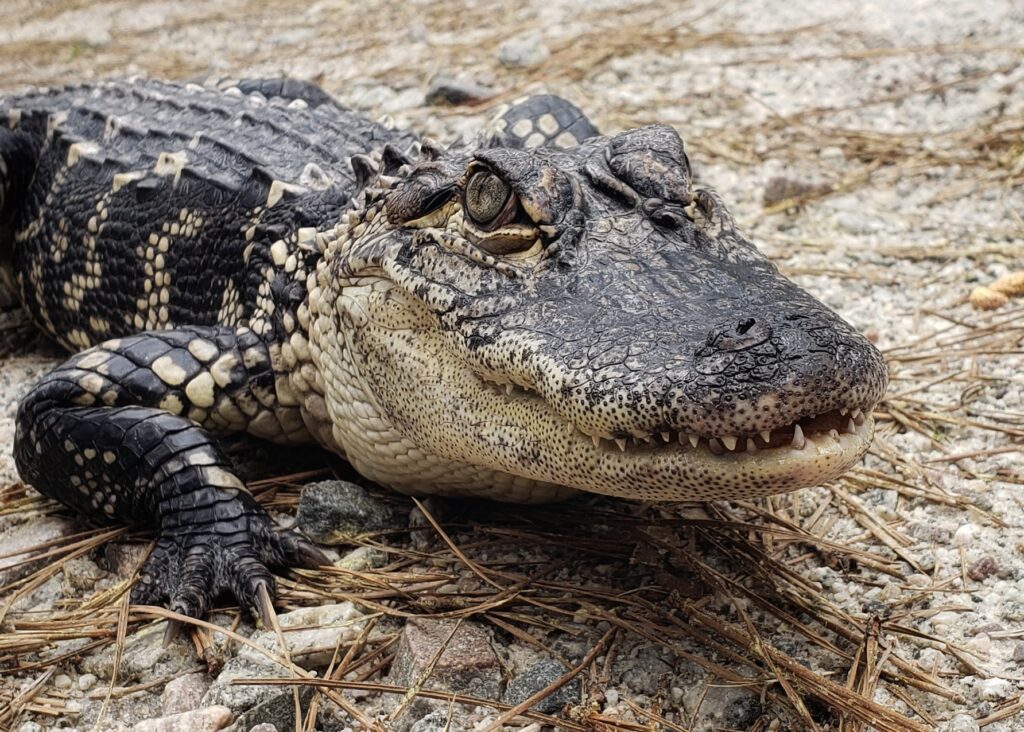
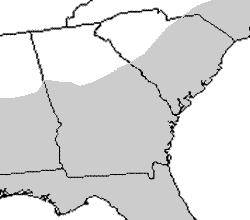
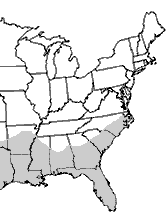
Description: American alligators (Alligator mississippiensis) inhabit the southeastern United States. Once a federally listed endangered species, American alligators have recovered and are common in many areas of the Southeast. The species is still federally listed as threatened because it looks like the American crocodile, which is endangered.
Alligators are long-lived animals whose life spans can exceed 60 years. Alligators are “cold-blooded,” meaning that they are ectothermic animals that cannot regulate their own body temperature, but assume the temperatures of their surrounding environment. To warm themselves, alligators bask in the sun, which is when they are frequently observed on the banks of water bodies. On hot summer days they can sometimes be seen basking with their mouths open. This is a cooling mechanism essentially equivalent to a dog panting. Ecologically, alligators are important predators and create important habitat for other wildlife by digging holes that hold water during droughts.
Range and habitat: Alligators occur on the Atlantic Coast of North America from Florida through coastal North Carolina, and along the Gulf Coast into Texas. Alligators are restricted to the Coastal Plain, which includes the Central Savannah River Area of Georgia and South Carolina. In South Carolina, alligators have been recorded to reach lengths of more than 13 feet.
Alligators live in swampy areas, rivers, streams, lakes and ponds. Females and juveniles occasionally use seasonal wetlands, such as Carolina Bays. Although they are primarily freshwater animals, alligators will also venture into brackish salt water. On the Savannah River Site, alligators are abundant in the Savannah River, its swamp and tributaries, L-Lake, Par Pond and other reservoirs on the site.
Did you know?
- Alligators and their relatives are the last of the living reptiles that were closely related to dinosaurs, and their closest modern kin are birds.
- There is only one other alligator species, the Chinese alligator.
- Alligators and crocodiles are related. However, alligators have rounded snouts, while most crocodile species have longer, pointed snouts. Also, crocodiles occur only in tropical and subtropical areas (only south Florida in the United States), while alligators live in somewhat colder climates.
- Being ectotherms, alligators do not need to eat much – a 100-lb dog will eat more in a year than an 800-lb alligator.
- Alligators have fairly poor eyesight. They have a “nictitating membrane” to protect their eyes so that they can see underwater. Alligators hear with ears that are located behind their eyes and are very sensitive to vibrations in the water.
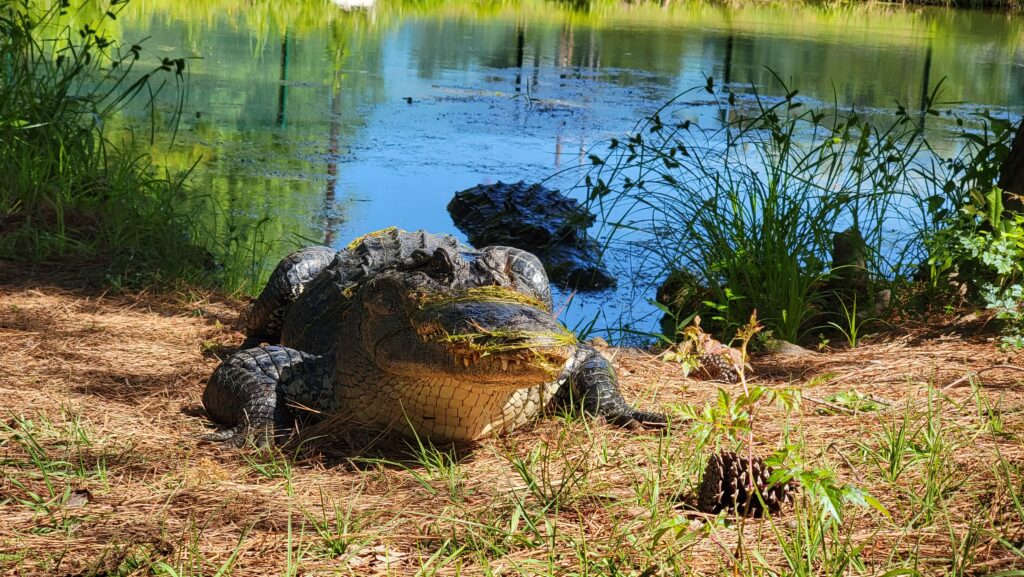
Alligators are frequently seen basking.
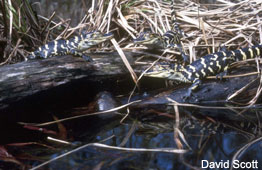
Juveniles also bask, but often in more protected areas with more dense vegetation.
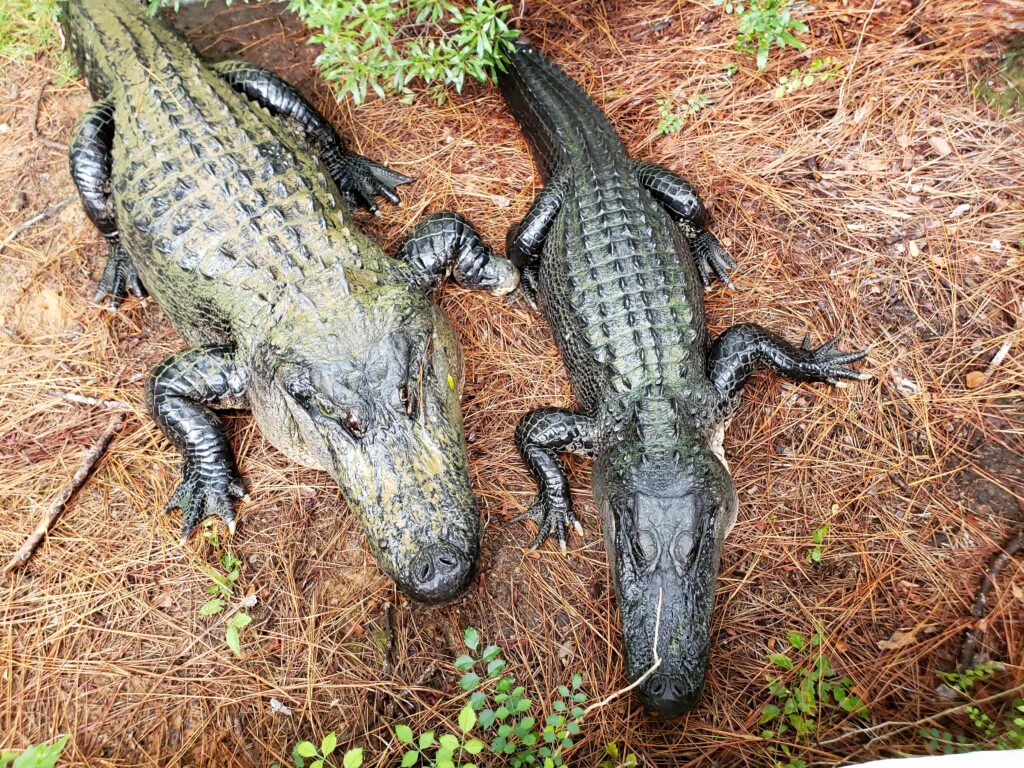
When ponds begin to freeze, alligators will stick their snouts above water. The snout is frozen in place, but the animal can still breathe.
Reproduction: Alligators are active year-round, but they are most active in the warmer months in Georgia and South Carolina. With the start of their breeding season in May, males “bellow ” to females and other males in the area. Alligator courtship is complex and involves a variety of vocalizations, head-slapping on the water’s surface, body posturing, snout and back rubbing, bubble blowing, and pheromone (scent) signals. By June, pairs have mated, and females begin building mound nests out of marsh reeds or other vegetation. This rotting vegetation helps warm the eggs during incubation.
Sometime during late June to mid-July, females lay between 20 and 60 eggs. The hard-shelled, white eggs are about 3 inches long and resemble goose eggs. The mother defends the nest against predators throughout the incubation period, approximately 65 days. When the eggs are ready to hatch, the mother alligator digs into the nest mound, opens any eggs that have not hatched, and carries the young down to the water. Females sometimes aggressively defend their young for more than a year.
Mother alligators that are killed or removed from the area cannot defend their nests or young, and the hatchlings often are doomed. If the young escape predation and can find enough food, they may grow between 3 and 8 inches in length yearly. When they reach lengths of about 6 feet, they are considered adults.
Prey: Alligators are opportunistic feeders; adults eat fish, turtles, wading birds, snakes, frogs, small mammals and even smaller alligators they find near the shoreline of their habitat. Young alligators feed on small fish and aquatic invertebrates, but in turn, they can be food for raccoons, crabs, large snakes, turtles, various types of wading birds and even fish.
Research: Scientists at the Savannah River Ecology Laboratory have studied American alligators on the Savannah River Site for more than 35 years. They have recorded population sizes, genetic patterns, distribution patterns and long-term population trends; animal sizes, sexes, activity periods, growth rates and reproductive efforts; diet, nutrition and energetics; responses to thermal effluent from reactors into cooling reservoirs; uptake of radionuclides; and the conservation of the species. Currently, SREL researchers work with alligators through long-term mark-recapture surveys, characterization of mating and paternity systems, and through studies on the effects of contaminants in long-lived reptiles.
Alligator Management in South Carolina: Alligators have a strong homing instinct; therefore, biologists have discovered that relocating individual alligators of concern is ineffective as they can return home even after they have been moved over 100 miles! Given this incredible ability to navigate, the SC Department of Natural Resources (DNR) has declared that alligator relocation is illegal in SC. Since relocation is not an option, when an alligator is “removed,” it is killed by a licensed alligator specialist.
In 1989, the SC DNR initiated a “nuisance” alligator program which permits contracted trappers to remove specific individuals that exhibit aggressive behaviors to humans or domestic animals, have become habituated to people (from feeding), show symptoms of debilitating illness or injury, or inhabit recreational waters intended primarily for swimming. Trappers remove 300-350 animals annually, most of them animals that have become habituated to humans because they have been fed.
In 2008, SC DNR established the alligator as a game animal and designated a hunting season. The season is regulated as a quota hunt and requires an application and permitting process. Hunters, who are only permitted for one season at a time, are only allowed to take one individual each year.
Conservation Challenges: Alligator populations are considered to have recovered from overharvesting pressures through supplemental farming practices and the reduced take of wild animals. However, alligators face plenty of challenges in our present-day landscapes. Expanding development in their habitat and the colonization of stormwater (freshwater catchment) lagoons along golf courses has forced an increase in interactions with resident humans. Since alligators cannot be relocated, all calls from property owners requesting removal result in the harvest of that animal. As human populations increase in these areas and tourism booms along coastal habitats, there are more and more situations where alligators are being fed and therefore, must ultimately be removed from the population. This situation is confounded by the fact that alligators have a bad (albeit biologically inaccurate) reputation from people misinterpreting the actual risk of alligator encounters.
Aside from problem interactions with humans, alligators are also experiencing direct habitat loss from development and the effects of pollution. Contaminants such as mercury and pharmaceuticals have led to decreased water quality and physiological effects in alligators exposed to these pollutants.
The future of the alligator lies in the hands of the people who live around alligators; their support is crucial in the development and implementation of long-term conservation and management of alligators and their habitats.
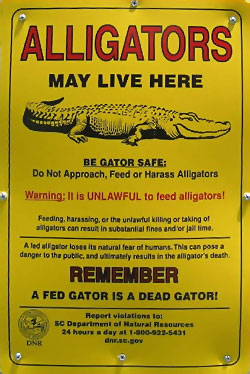
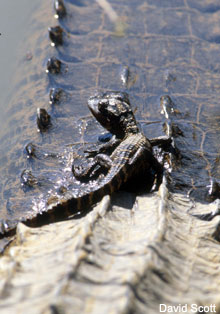
Send your suggestions, comments, or questions to: srelherp@gmail.com.
Please include locality data for identifications.
